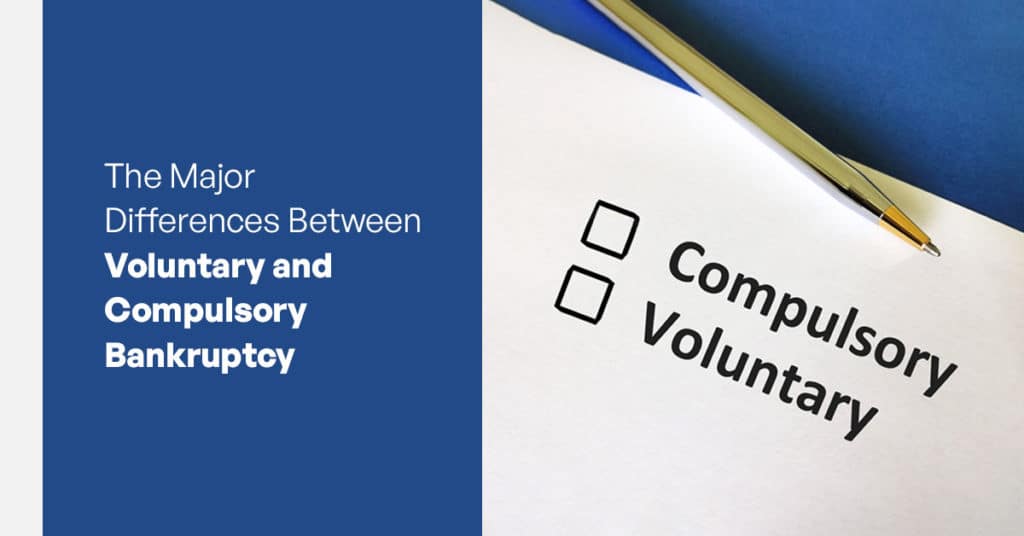In business and personal finance, the terms ‘voluntary bankruptcy’ and ‘compulsory bankruptcy’ often surface when discussing insolvency and liquidation. Understanding the difference between the two is important for anyone experiencing financial difficulties in the UK.
What is voluntary bankruptcy?
Voluntary bankruptcy occurs when an individual or a company, unable to pay debts as they fall due, chooses to declare bankruptcy themselves. This decision is typically driven by the realisation that the financial situation is unsustainable, and declaring bankruptcy offers the best path forward to manage debt and seek a fresh start. It provides a structured framework to address creditors’ claims and potentially discharge debts, allowing a more orderly resolution than waiting for creditor actions.
In the UK, initiating voluntary bankruptcy involves presenting a petition to the court, which then assesses the debtor’s financial circumstances. If approved, a licensed Insolvency Practitioner (IP) is appointed to oversee the administration of the bankruptcy estate. The IP’s role is crucial, ensuring assets are fairly distributed among creditors and that the process complies with legal requirements, providing debtors with guidance and expertise throughout the proceedings.
Voluntary bankruptcy offers a proactive approach for debtors to regain control over their financial affairs under the guidance of a professional, facilitating an organised and equitable resolution to financial difficulties.
The process of voluntary bankruptcy
When a debtor opts for voluntary bankruptcy, they take proactive steps to address their financial liabilities. This process allows them to gain control over the situation rather than being subjected to legal actions initiated by creditors. Once the bankruptcy order is granted the IP assumes responsibility for managing the debtor’s assets and distributing them among creditors under the law.
Key considerations in voluntary bankruptcy
Choosing to enter voluntary bankruptcy should be a well-considered decision based on professional advice, reflecting a strategic approach to managing financial distress effectively. It offers an organised framework for addressing insolvency issues while safeguarding the rights of both debtors and creditors. The voluntary nature of this process allows debtors to begin proceedings on their terms, providing a degree of control over the liquidation of assets and the distribution of proceeds.
Voluntary bankruptcy aims to strike a balance between fulfilling financial obligations through asset liquidation and providing debtors an opportunity to achieve financial rehabilitation. This ordered approach not only seeks to settle debts fairly but also enables debtors to potentially emerge from bankruptcy with a clearer financial slate, paving the way for future financial stability.
What is compulsory bankruptcy?
In contrast to voluntary bankruptcy, compulsory bankruptcy is initiated by creditors who petition the court to declare a debtor bankrupt. This route is taken when creditors believe the debtor is either intentionally evading payment despite having the means to settle debts or genuinely incapable of meeting financial obligations without legal intervention. It represents a formal legal process designed to compel debtors to address outstanding debts through court-mandated proceedings, making sure that creditors have an organised mechanism to recover what they are owed under the law.
The process of compulsory bankruptcy
Compulsory bankruptcy begins with one or more creditors applying to the court for a bankruptcy order against a debtor. The court reviews the evidence presented, which may include unpaid invoices, failed negotiations, or other indicators of financial distress. If the court determines the debtor is indeed insolvent and unable to meet their financial obligations, it issues a bankruptcy order. A licensed Insolvency Practitioner (IP) is then appointed to oversee the liquidation of assets and ensure the proceeds are distributed equitably among creditors.
Unlike voluntary bankruptcy, where debtors take the initiative to file for bankruptcy as a strategic decision, compulsory bankruptcy is driven by external creditors seeking legal redress to recover outstanding debts. This process underscores creditors’ rights to pursue formal legal channels when debtors fail to meet financial obligations, offering a structured approach to resolving financial disputes under court supervision.
Key considerations in compulsory bankruptcy
For debtors facing compulsory bankruptcy, the process can be daunting as it involves legal proceedings and a loss of autonomy over the bankruptcy process. However, it’s also a structured mechanism for creditors to seek repayment of outstanding debts through the systematic liquidation of assets. This court-supervised approach means that creditors have a fair opportunity to recover as much of their debts as possible under the guidance and oversight of a court-appointed Insolvency Practitioner (IP). While challenging for debtors, compulsory bankruptcy offers a regulated framework that aims to balance the creditors’ rights with the need for a structured resolution to financial difficulties.
Contrasting the two approaches
Voluntary and compulsory bankruptcy differ primarily in their initiation and control:
- Initiation: Voluntary bankruptcy is initiated by the debtors themselves, whereas compulsory bankruptcy is started by creditors through court action.
- Control: Debtors maintain more control over the process in voluntary bankruptcy, including the choice of IP, whereas compulsory bankruptcy involves court oversight and creditor-driven decisions.
Both routes aim to achieve a fair distribution of assets among creditors while allowing debtors a chance to settle their financial affairs and move forward with renewed financial stability.
The path forward
Understanding the distinction between voluntary and compulsory bankruptcy is important for anyone facing financial hardship in the UK. Whether considering voluntary action to regain control or responding to creditor demands through compulsory measures, seeking professional advice is essential to handle the complexities of insolvency law.
For personalised advice on which insolvency solution best suits your needs, our team of qualified Insolvency Practitioners is here to help. Contact us today via our live chat, email at mail@Simpleliquidation.co.uk, or call us on 0800 246 5895. We offer free, impartial advice authorised by the Institute of Chartered Accountants in England and Wales, ensuring your liquidation process is as cost-effective and efficient as possible. Understanding your options and taking decisive action can pave the way to financial recovery and a fresh start. Let us guide you through the process with expertise, care and compassion.




